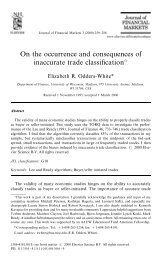A generic framework for Arabic to English machine ... - Acsu Buffalo
A generic framework for Arabic to English machine ... - Acsu Buffalo
A generic framework for Arabic to English machine ... - Acsu Buffalo
You also want an ePaper? Increase the reach of your titles
YUMPU automatically turns print PDFs into web optimized ePapers that Google loves.
3.4. LEXICAL REPRESENTATIONS FOR VERBS<br />
Hence the same representations are used <strong>for</strong> all languages (where appropriate), e.g. the<br />
logical structure <strong>for</strong> <strong>Arabic</strong> and <strong>English</strong> ‘die’ (intransitive) would be BECOME dead’(x).<br />
The elements in all capitals, INGR and BECOME, are modifiers of the predicate in the<br />
logical structure; their function will be explained below. The variables are filled by lexi-<br />
cal items from the language being analysed; <strong>for</strong> example, the <strong>English</strong> sentence The dog<br />
died would have the logical structure BECOME dead’ (dog), while the correspond-<br />
ing <strong>Arabic</strong> sentence ālklb māt . “The dog died” would have the logical<br />
structure BECOME dead’ (ālklb) should be this sentence start with the verb<br />
māt ālklb. States are represented as simple predicates, e.g. broken’ (x),<br />
be-at’(x,y), and see’(x,y). There is no special <strong>for</strong>mal indica<strong>to</strong>r that a predicate<br />
is stative.<br />
The logical structure, be’(x,[pred’] ) is <strong>for</strong> identificational constructions, e.g.<br />
Omar is a student, and attributive constructions, such as The watch is broken require a<br />
different logical structure. In this logical structure the second argument is the attribute or<br />
identificational NP, e.g. be’ (Ayesha, [tall’]), be’(Omar,[student’]).<br />
The primary criteria <strong>for</strong> distinguishing between attributive constructions and result state<br />
constructions is whether the attribute is inherent, e.g. Coal is black (be’ (coal,<br />
[black’])), or whether it is the result of some kind of process, e.g. The fire black-<br />
ened the wood (... BECOME black’(wood)) (Van Valin and LaPolla 1997).<br />
3.4.1 Agents, effec<strong>to</strong>rs, instruments and <strong>for</strong>ces<br />
In ‘Zaid is cutting the bread with a knife’, an EFFECTOR, typically human, manipulates<br />
a knife and brings it in<strong>to</strong> contact with the bread, whereupon the interaction of the knife<br />
with the bread brings about the result that the bread becomes cut. This may be represented<br />
as in (3.3). (The main CLAUSE in the logical structure is italicized.)<br />
39
















